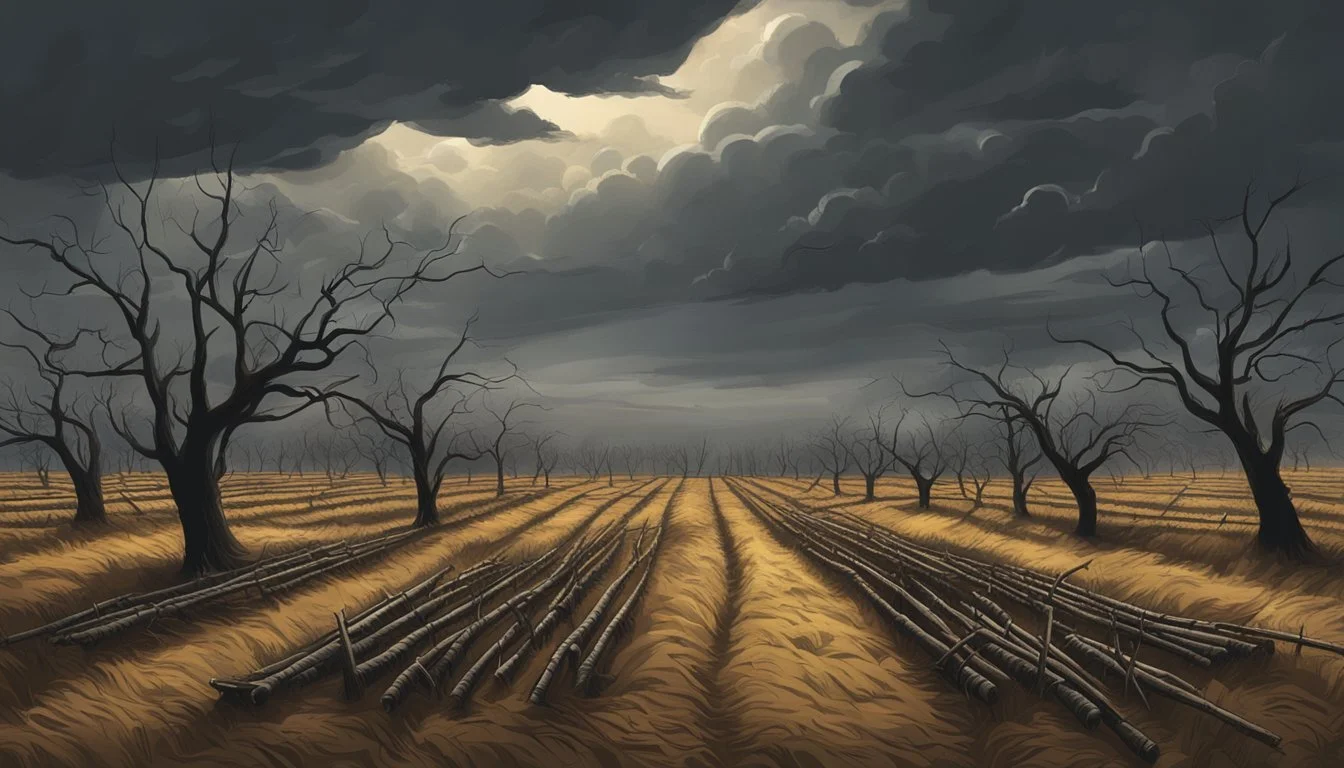Harvest of Horror: Juan Corona's Orchard of Death
California's Deadliest Serial Killer
In 1971, a gruesome discovery shook the quiet farming community of Yuba City, California. Juan Corona, a farm labor contractor, was arrested for the brutal murders of 25 migrant workers. The victims were found buried in shallow graves in peach orchards along the Feather River, leading to one of the most shocking mass murder cases in U.S. history.
Corona's killing spree marked him as America's deadliest known serial killer at the time, surpassed only two years later by Dean Corll's crimes. The case became infamous for its scale and the brutal nature of the killings, with many victims hacked to death by machete. Corona's motive remained unclear, adding to the mystery and horror surrounding the murders.
The discovery of the bodies sent shockwaves through the agricultural community and brought national attention to the often-overlooked lives of migrant farm workers. Corona's trial captivated the public and shed light on the vulnerabilities faced by these workers in rural America. The case of the "Machete Murderer" continues to haunt California's criminal history decades after the killings.
Overview of the Case
In 1971, a chilling discovery shook Sutter County, California. Juan Corona, a farm labor contractor, was arrested for the murders of 25 migrant workers. The victims' bodies were found buried in shallow graves near orchards along the Feather River.
The case began to unravel when a peach farmer noticed suspicious holes in his orchard. Upon investigation, police unearthed the first of many bodies. As the search expanded, more graves were discovered on various farms in the area.
Corona's victims were all male migrant workers, ranging in age from 40 to 68. Many had been brutally attacked with a machete, leading to Corona's nickname "the machete murderer." Some bodies showed signs of sexual assault.
The scale of the killings was unprecedented at the time. It became one of the most notorious mass murder cases in U.S. history. The rural setting and the vulnerable status of the victims added to the public's shock and outrage.
Prosecutors built their case on physical evidence found at Corona's home and work sites. This included bloodstained clothing, receipts with victims' names, and a ledger book containing cryptic entries believed to reference the murders.
The trial garnered significant media attention. Corona was ultimately convicted of all 25 murders in 1973. He received 25 concurrent life sentences for his crimes.
Profile of Juan Corona
Juan Corona was a Mexican-born serial killer who murdered 25 migrant workers in California in 1971. His crimes shocked the nation and revealed a dark underbelly to the agricultural labor system.
Early Life and Background
Juan Corona was born on February 7, 1934 in Jalisco, Mexico. He immigrated to the United States in 1950 at age 16, settling in California. Corona had a troubled youth and struggled with mental health issues.
In 1956, he suffered a mental breakdown and was diagnosed with schizophrenia. He spent time in a mental hospital receiving shock treatments. After his release, Corona married and had four daughters.
Labor Contractor Career
Corona became a successful labor contractor in Yuba City, California during the 1960s. He recruited migrant workers from Mexico to work on local farms.
His position gave him access to vulnerable laborers. Corona managed payroll and housing for the workers, exerting significant control over their lives.
Many of his victims were transient farm workers with few connections, making them easy targets.
Psychological Profile
Experts described Corona as a paranoid schizophrenic with sadistic tendencies. He harbored deep-seated anger and resentment toward the migrant workers he employed.
Corona's murders were brutal, involving repeated stab wounds and mutilation. He kept a ledger with cryptic notes about his victims.
His mental illness likely fueled his violent impulses, though he was found legally sane during his trial. Corona never admitted guilt or showed remorse for his crimes.
Discovery of the Orchards of Death
In May 1971, a grisly discovery near Yuba City, California unveiled one of America's worst serial murder cases. The investigation rapidly uncovered multiple shallow graves containing mutilated bodies, shocking the local community and law enforcement.
Initial Investigations
On May 19, 1971, a peach farmer noticed a suspicious hole in his orchard. When police arrived, they unearthed the body of Kenneth Whitacre. Four days later, they found eight more corpses nearby.
The bodies showed signs of brutal machete attacks. Many victims had deep slashes across their heads and upper bodies. Some had been stabbed repeatedly.
Sutter County officials launched a massive search of local orchards. They used bulldozers to excavate large areas along the Feather River. The death toll rose quickly as more graves were found.
Shocking Revelations and Evidence
By June 4, investigators had recovered 25 bodies from shallow graves on the Sullivan Ranch and neighboring properties. All were male migrant workers, aged 40-60.
Key evidence emerged:
A meat receipt with Juan Corona's name
Bank statements belonging to victims
Blood-stained machete and other weapons
Corona, a local labor contractor, became the prime suspect. Police arrested him on May 26, 1971. A search of his home and van yielded further incriminating items.
The scale and brutality of the murders stunned the nation. It was then the largest mass murder case in U.S. history. Corona's trial began in September 1972, drawing intense media coverage.
The Victims
Juan Corona's victims were predominantly migrant farm workers seeking employment in California's agricultural sector. Their deaths devastated families and sent shockwaves through local communities.
Profiles of the Victims
The 25 men murdered by Corona ranged in age from 40 to 68. Most were itinerant laborers from Mexico and other parts of the United States. They came to the Yuba City area seeking seasonal work in the orchards and fields.
Some victims, like Sigrid Beierman, were last seen boarding Corona's blue school bus used to transport workers. Others, such as Melford Sample, had recently arrived in town looking for jobs.
Many victims were single men with few local connections, making them vulnerable targets. Their transient lifestyles meant some disappearances went unnoticed for weeks.
Impact on the Community
Corona's killing spree instilled fear in Yuba City's farming communities. Local orchards became associated with gruesome discoveries rather than bountiful harvests.
Farm owners grew wary of hiring unfamiliar laborers. Some migrant workers left the area, fearing for their safety. Those who stayed faced increased scrutiny and suspicion.
Families of victims struggled with grief and uncertainty. Many bodies remained unidentified for months or years. The murders highlighted the precarious lives of migrant farm workers and their often-invisible presence in rural communities.
Criminal Case and Trial
Juan Corona faced justice for his heinous crimes in a landmark legal proceeding. The case revealed shocking details of the murders and presented compelling evidence against the accused.
25 Counts of Murder
Corona was charged with 25 counts of first-degree murder. The victims were migrant farm workers whose bodies were discovered in shallow graves near Yuba City, California in 1971.
Prosecutors alleged Corona lured the men with offers of work before killing them. The murders were brutal, with many victims showing signs of machete wounds and severe head trauma.
Evidence and Conviction
Key evidence included:
A ledger book with victims' names
Receipts linking Corona to grave sites
Bloodstained machete and gun found in Corona's home
Eyewitness accounts placing Corona at crime scenes
After a 13-week trial, the jury found Corona guilty on all 25 counts. He received 25 concurrent life sentences.
Legal Representation and Appeals
Corona's initial defense was criticized as inadequate. His first attorney, Richard Hawk, presented no witnesses and minimal evidence.
In 1978, an appeals court overturned the conviction citing incompetent representation. A retrial began in 1982.
Corona's new defense team argued he suffered from schizophrenia. Despite this, the second jury also found Corona guilty on all counts.
Subsequent appeals were unsuccessful. Corona remained in prison until his death in 2019.
Closure and Aftermath
Juan Corona's case reached its legal conclusion, but the aftermath continued for decades. His convictions led to multiple life sentences and a series of unsuccessful appeals.
Life Sentences and Appeals Process
Corona received 25 consecutive life sentences for his crimes in 1973. He appealed his conviction, resulting in a retrial in 1982. The second trial also ended in guilty verdicts on all counts. Corona's legal team filed several appeals over the years, but none succeeded in overturning his convictions.
The appeals court consistently upheld the original verdicts. Corona attended multiple parole hearings throughout his incarceration. Each time, the parole board denied his requests for release, citing the severity of his crimes and potential risk to public safety.
Corona's Life Post-Conviction
Corona spent most of his post-conviction life at Corcoran State Prison in California. He faced numerous health challenges in his later years, including dementia and heart problems.
Prison officials reported that Corona suffered multiple heart attacks while incarcerated. His declining health impacted his daily life in prison and his ability to participate in legal proceedings.
Corona died on March 4, 2019, at the age of 85. He never admitted guilt for the murders, maintaining his innocence until the end. His death marked the final chapter in one of California's most notorious criminal cases.
Context and Legacy
Juan Corona's crimes shook California and the nation, leaving a lasting impact on law enforcement and public consciousness. His case highlighted vulnerabilities in migrant worker communities and exposed flaws in investigative procedures.
Influence on Legal and Forensic Practices
Corona's trial led to significant changes in evidence handling and crime scene investigation. Forensic teams developed new techniques for excavating and preserving buried remains. The case also prompted improvements in fingerprint analysis and DNA collection methods.
Law enforcement agencies implemented better protocols for identifying missing persons, especially among transient populations. Corona's crimes exposed gaps in tracking seasonal workers, leading to enhanced record-keeping systems.
The trial set precedents for handling high-profile serial killer cases. It influenced jury selection processes and media management strategies for sensational criminal proceedings.
Comparative Cases
Corona's crimes occurred during a period of increased serial killer activity in the United States. His case shared similarities with other notorious killers like John Wayne Gacy, who also targeted vulnerable individuals.
Unlike many serial killers who sought notoriety, Corona maintained a low profile. This behavior pattern intrigued criminologists and psychologists, leading to new studies on killer motivations and personalities.
The scale of Corona's murders rivaled that of other mass murderers, but his method of burying victims in orchards was unique. This aspect of the case continues to fascinate true crime enthusiasts and researchers.
Cultural and Societal Impact
Juan Corona's crimes left a profound mark on California's agricultural communities and the media landscape. His actions exposed deep-rooted issues affecting migrant workers and shaped public perceptions of serial killers.
Media Portrayal
The Associated Press and other news outlets extensively covered Corona's case. His crimes captivated the public, becoming one of the most notorious serial killer stories of the early 1970s. The media focused on the brutal nature of the killings and the shocking discovery of multiple bodies in fruit orchards.
Television programs and true crime books explored Corona's background and motives. Many accounts emphasized his Mexican heritage and immigrant status, sometimes reinforcing stereotypes. The case also highlighted the vulnerabilities of migrant farm laborers in California's agricultural regions.
Impact on the Migrant Community
Corona's crimes cast a shadow over the Sacramento Valley's migrant worker population. Many farm laborers feared for their safety, and some left the area. Northern California farmers faced challenges in recruiting seasonal workers due to heightened concerns.
The case exposed the precarious living conditions and lack of protections for migrant farm laborers. It sparked discussions about improving safety measures and living standards for this vulnerable group. Some advocacy organizations used the tragedy to push for better legal protections and social services for migrant workers.
Local communities grappled with increased tensions and suspicion. The murders strained relationships between farm owners and workers, as well as between different ethnic groups in the region.







